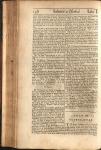

 I. The Names. It seems not to be known to the Greeks, and therefore we have no universally received Greek name for it, only Gesner thought it to be Dodecatheon Plinij: Lugdunensis thinks it may be Crias Apulei, and calls it Cucullata: but it is called in Latin, Pinguicula by Gesner, and from him all others call it so: others Lingula Plinij, Viola humida, Viola Palustris: Bauhin calls it, Sanicula montana flore calcare donata: with us it is called, Sanicula Eboracensis (because it grows so plentifully in Yorkshire.) In English it is called Butter-wort, and Butter-root, because of the Unctuosity of the Leaves; or else from Fattening, as Gerard says, who also saith, they call it White Rot, and not White Root, because the Countrey people think, that if their Sheep should eat it, that it would give them the Rot; and they give it the Epithite White, from the color of the Leaf: as they have another which they call Red-Rot, which is Pedicularis, Red-Rattle.
I. The Names. It seems not to be known to the Greeks, and therefore we have no universally received Greek name for it, only Gesner thought it to be Dodecatheon Plinij: Lugdunensis thinks it may be Crias Apulei, and calls it Cucullata: but it is called in Latin, Pinguicula by Gesner, and from him all others call it so: others Lingula Plinij, Viola humida, Viola Palustris: Bauhin calls it, Sanicula montana flore calcare donata: with us it is called, Sanicula Eboracensis (because it grows so plentifully in Yorkshire.) In English it is called Butter-wort, and Butter-root, because of the Unctuosity of the Leaves; or else from Fattening, as Gerard says, who also saith, they call it White Rot, and not White Root, because the Countrey people think, that if their Sheep should eat it, that it would give them the Rot; and they give it the Epithite White, from the color of the Leaf: as they have another which they call Red-Rot, which is Pedicularis, Red-Rattle.
II. The Kinds. It is a singular Species of the Sanicles; being Genus to none else.
III. The Description. It has a Root composed of divers white Fibres, or small Strings, which die not in the Winter, but abide all the time with green Leaves upon them: From this Root spring forth divers fat and long Leaves Iying upon the ground round about it, broad at the bottom, and pointed at the end, of a pale green color on the upper side, but white underneath, folded together at their first rising which then are more White. From among these Leaves rise up two or three, or more, slender naked Stalks about five or six Inches high, bearing but one only Flower at top of each Stem, set in a small green husk in form somewhat like a Violet Flower, or those of Larks Heels or Spurs, having a small Heel or Spur behind, in some of a purple, in others of a more blew color, and in some white. When the Flowers are past, there come in their places small pointed round heads, in which is contained small, long, black Seed.
IV. The Places. It is chiefly found in the Common Field, and in several Bogs on the Hills in Yorkshire and in many places also in the West Country and Wales: as also in a Common, about a Mile from Oxford, near a Village called Herington. Gerard says, it grows in England in squashy wet Grounds, and will not yield to any Transplanting or Cultivating of it; and that it grows especially in a field called Crag-close, and at Crosby, and Ravensweith in Westmorland; upon Ingleborow Fels, twelve Miles from Lancaster; and in Harwood in the same County, near to Blackburn; ten Miles from Preston in Aunderness upon the Bogs, and Marsh Grounds: and in the Boggy Meadows about Bishops-Hatfield: also in the Fenns in the way from London to Whitlesea Mere in Huntington-shire: It grows also in Hampshire, and in great abundance in many places in Wales.
V. The Times. It Flowers towards the latter end of May, and all the Month of June, even to July, (according as the Weather proves) and the Seed is ripe not long after.
VI. The Qualities. It is Temperate in respect to heat or cold, and Drying in the Second Degree. It is Astringent, and Cathartick, like Rhubarb; Consolidative, and Traumatick, or Vulnerary.
VII. The Specification. It is dedicated to the curing of Green Wounds, and healing of Recent Ruptures in Children.
1. A liquid Juice of the Plant.
2. A Syrup.
3. An Ointment.
4. A Balsam.
The Virtues.
IX. The liquid Juice. Country People, who live where it grows do use to wash their Hands with it, when they are Chapt by the Wind or Weather: and in Yorkshire they anoint the Dugs of their Kine, with the Fat and Oily Juice, when they are bitten with any Poisonous Worm or Fly, or are Chapt or Rift by Weather, or any other means.
X. The Syrup. The Poorer sort of People in Wales, make a Syrup thereof as of Roses, and therewith Purge themselves, and their Children: they mix it with Broth for the same purpose, and so it purges Flegm effectually. Dose from two to four spoonfuls.
XI. The Ointment. They also with the Herb make an Ointment, which is held to be singularly good (and that by the Experience of some Physicians) against the Obstructions of the Liver.
XII. The Balsam. It is said to cure Ruptures in Children, being applied Plaster-wise: It is a singular Vulnerary, for it digests, cleanses, and heals Green Wounds in any part, being highly Astringent, Drying, and Consolidating, not much inferior to any of the Wound Herbs.
Botanologia, or The English Herbal, was written by William Salmon, M.D., in 1710.
This chapter has been proofread by Nick Jones.

